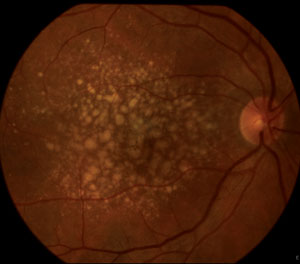Research now suggests treatments currently used for other conditions such as wet age-related macular degeneration (AMD) could also work for dry AMD. Using a mouse model, investigators from the Gifu Pharmaceutical University found that injecting placental growth factor (PlGF) into the retinas of mice before and after exposure to intense light—a procedure that mimics dry AMD-like conditions—aggravated the degeneration, contradicting previous study results.
 | |
| Soft drusen seen in a patient with AMD. Photo: Jay Haynie, OD. |
In response, they tried injecting anti-PlGF, an antibody already found in the wet AMD treatment aflibercept, and found it protected against retinal degeneration induced by light exposure.
“There is a very great likelihood that aflibercept shows efficacy in dry AMD,” study author Hideaki Hara, PhD, of Gifu Pharmaceutical University’s Department of Biofunctional Evaluation, said in a press release.
“Currently, there is no effective treatment for dry AMD, and our treatment revolves around lifestyle modification, nutrition/supplementation and monitoring for conversion to wet AMD,” says Steven Ferrucci, OD, of the US Department of Veterans Affairs in North Hills, Calif., and professor at the Southern California College of Optometry at Marshall B. Ketchum University in Los Angeles. “It is possible that this already-approved medication could have some positive effects in dry AMD patients based on this study.”
“Repurposing an existing drug in such a manner could save time and money, rather than developing a novel drug,” he adds. “However, it must be understood that this is an animal model only, and it would be a long time until we know whether this is a viable treatment in humans.”
Still, the new findings highlight the importance of research into treatment options for dry AMD, as well as staying abreast of breakthroughs that may benefit patients with this disease.
Izawa H, Inoue Y, Ohno Y, et al. Protective effects of antiplacental growth factor antibody against light-induced retinal damage in mice. Invest Opthalmol Vis Sci. 2015;56(11):6914.
